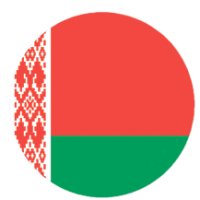About 200 TV programs and radio stations originating from the region mentioned above are broadcasted via “Belintersat-1” satellite. In the course of the Sub-Saharan Africa satellite broadcasting monitoring the reference and analytical overview has been prepared. The latter the Byelorussian satellite operator is willing to share with the visitors of the intersputnik.int web portal. We ask for your attention to the fact that the overview reflects the situation in the markets in Q4 2020.
The Euroconsult experts forecast the decrease in satellite operators' revenues from video operations until 2029. However, in Sub-Saharan Africa countries the satellite video distribution market demonstrated some growth signs.
For example, from 2017 to 2019 there was 23 per cent increase in the number of households enjoying satellite TV reception in Nigeria, while in Ghana the corresponding index was 19 per cent (source: broadbandtvnews.com/2020/06/25/satellite-tv-gaining-popularity-in-ghana-and-nigeria/).
For the purposes of the operations' planning across Sub-Saharan Africa the preparation of this regional market’s overviews, enumerating around 50 states, seems to be helpful. Such an attempt is made herewith. The raw data to be analyzed have mainly been taken at Internet portal lyngsat.com.
TV channels of only three African nations were not represented in satellite packages. They were Liberia, São-Tomé and Principe as well as Seychelles. It is worth noting that the last two countries are small island states. On the other hand the first five leading countries according by using space communications for video distribution were Ghana, Nigeria, Ethiopia, South Africa and Kenya.
The comparison of the number of channels distributed via satellites with such countries' basic features as area, population, density, GDP, exports of goods and services percentage of GDP revealed the strong relationship between the TV satellite content volume and population size with correlation rate 0.71 as well as between the TV satellite content volume and GDP with correlation rate 0.68. On the other hand the relationships between the TV satellite content volume with such national features as area size, population density and the export percentage in GDP turned out to be very weak with correlation rate less than 0,25 in all three cases.
The national TV content representation in satellite packages has been compared with the popularity of one of the UN official languages in related countries. The biggest content's volume was revealed to come from the English-speaking countries, making up 58 percent of the entire content (while their share in the region's population size is 46 percent). They were followed by French-speaking nations with the satellite content share of 23 percent and the population share of 29 percent, Arabic-speaking nations and Ethiopia as the separate cultural and language zone with the satellite content share of 15 percent and the population share of 22 percent and by Portuguese- and Spanish-speaking nations with the satellite content share of 3 percent and the population share of 5 percent. In that way the English-speaking countries' role as the originators of satellite TV content was slightly hypertrophied as compared to their portion in the regional population.
Generally speaking it will not be mistake to affirm that the video content representation in satellite TV packages is defined mostly by the level of TV content production in each country. That is the factor which can explain the Ghana's leadership in the number of TV channels distributed via satellites, while its position in the population size is only the 11th and in GDP it is No.14.

The "big three" fleet distributed the majority of TV channels. According to the broadcasted content units' number their common market share reached 78 percent.
If counted by the number of TV channels distributed via every single satellite the first ten leadership has also been made up mainly by the "big three" space vehicles. The fact that Israeli operator Spacecom has ensured servicing almost all its African clients, being TV media content's distributors, via HTS satellite Amos-17 is worse special noting. It proves that even a single orbital unit's operation allows satellite operation to conquer sufficient market share under the condition that the successful market strategy has been chosen.
There was strong relationship between each operator's ranking by the number of TV channels' distributed and the amount of countries served with correlation rate 0.98. In the top 10 operators by the latter indicator there have been 9 out of 10 leaders according to the number of TV channels broadcasted. This fact may be regarded as the confirmation of the importance to expand the geography of market presence by operators.
75 percent of the TV channels were distributed in Ku-band, while for the rest 25 percent C-band has been applied. As for the accessibility of the content’s units 73 percent of them have been broadcasted open and 27 percent have been encrypted.
The territories of the African TV channels’ distribution have been as follows:
- Sub-Saharan Africa countries, i.e. the origination region (62 percent);
- Middle East, Western Asia and the Mediterranean (9 percent);
- Western Europe (7 percent);
- North America (1 percent).
Few channels were broadcasted in Asian and Pacific region and via steerable beams.
21 percent of the African TV channels targeted simultaneously at 3 or more regions by means of satellite super-wide beams. In most cases these regions have been Sub-Saharan Africa, Europe, the Middle East and a part of South America. It may be noted from the above mentioned that content distributors targeted mainly the markets of the TV channels’ origination. At the same time super-wide beams’ satellite resources were also highly demanded by them. But the Sub-Saharan African content’s relatively little share was broadcasted outside its own region. This fact indicates some additional services provision expansion opportunities for satellite operators.



The Sub-Saharan African TV content was distributed within about 120 packages.
Only 8.7 percent of the TV channels seemed to have been distributed beyond the packages. Thus establishing the cooperation with TV packages rights-owning distributors as well as launching new multiplexes looked like a matter of priority for satellite operators as compared to working with single TV channels. Operators Eutelsat and SES may be referred to as the examples of their own TV packages initiators
There were six coinciding names in the top 10 packages according to the numbers of TV channels distributed and the originating countries of these TV channels. For satellite operators it looks like to mean that the increase in number of countries providing their content into TV packages to be distributed is rather important than indifferent. However when working with the content originating from the countries with highly developed media-production sphere they can also attain considerable amount of TV channels to be accumulated in multiplexes. For example such big packages as StarTimes TV and Sentech have accumulated five countries’ content, while Ugandan mux reached high ranking position with only three originating nations.


This overview indicated that 34 percent of the TV channels were distributed at one and same time within 2 or more packages. The subsequent results were:
- 21 percent for 3 or more packages;
- 13 percent for 4 or more packages;
- 8 percent for 5 or more packages;
- 4 percent for 6 or more packages and just 1 percent for 7 or more packages.
The record in the number of packages used for broadcasting one and same TV channel was 11. The increase in the TV packages’ amount and including the existing TV channels thereto is thus also one of the demand growth sources for satellite operators’ services.
---
Author:
Mr. Leonid Fedotov «Belintersat» (Belarus)

Senior Business Development Consultant, Sales Department, Ground Control Station, State Enterprise “Precise Electromechanics Factory”
---
The Russian version of the Article is available for downloading in FILES section.
 Operations Committee
Operations Committee
